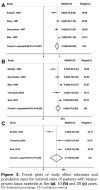A Systematic Review and Meta-analysis of Prevalence of Biopsy-Proven Lupus Nephritis
- PMID: 29900975
- PMCID: PMC5864167
- DOI: 10.5606/ArchRheumatol.2017.6127
A Systematic Review and Meta-analysis of Prevalence of Biopsy-Proven Lupus Nephritis
Abstract
Objectives: This study aims to conduct a meta-analysis to clarify the epidemiologic characteristics of biopsy-proven lupus nephritis (BPLN), including those relating to its prevalence and prognosis.
Patients and methods: A literature search for relevant studies was conducted in the electronic databases of PubMed, Google Scholar, Embase, and Cochrane trial register. The following search terms were used for original articles published between January 1982 and April 2016: "lupus nephritis" or systemic lupus erythematosus ('SLE') or 'systemic lupus erythematous' and "pathology" or 'epidemiology' or prevalence or incidence. Pooled estimates with 95% confidence intervals were calculated.
Results: Nineteen studies were included (mean age of SLE patients at renal biopsy: ~30 years). Of total BPLN patients, 85% were females. BPLN developed in 29% of SLE patients, and accounted for 60% of secondary glomerular diseases in renal biopsy databases. BPLN prevalence among SLE patients was higher in Saudi Arabia compared with pooled Europe/USA data (43% vs 26%, p<0.05). Pooled BPLN prevalence among secondary glomerular diseases patients was higher in Asian/Latin American countries than in Europe (63% vs 34%, p<0.05). Overall five-, 10- and 20-year survival rates of BPLN patients were 94%, 86%, and 71%, respectively, which were higher than those before 1995 (84%, 72%, and 52%, respectively) and lower than those after 1995 (96%, 89%, and 80%, respectively) (all p<0.05). Class IV nephritis, present in 40% of BPLN patients, was a risk factor for renal failure that contributed to poor prognosis.
Conclusion: Lupus nephritis is a common complication of young female patients with SLE, and the most prevalent etiology of secondary glomerular diseases. Attention should be paid to class IV nephritis due to its high frequency and association with poor prognosis.
Keywords: Biopsy-proven lupus nephritis; epidemiology; meta-analysis.
Conflict of interest statement
Conflict of Interest: The authors declared no conflicts of interest with respect to the authorship and/or publication of this article.
Figures



References
-
- Fortuna G, Brennan MT. Systemic lupus erythematosus: epidemiology, pathophysiology, manifestations, and management. Dent Clin North Am. 2013;57:631–655. - PubMed
-
- Gurevitz SL, Snyder JA, Wessel EK, Frey J, Williamson BA. Systemic lupus erythematosus: a review of the disease and treatment options. Consult Pharm. 2013;28:110–121. - PubMed
-
- Zubair A, Frieri M. Lupus nephritis: review of the literature. Curr Allergy Asthma Rep. 2013;13:580–586. - PubMed
-
- Zabaleta-Lanz M, Vargas-Arenas RE, Tápanes F, Daboin I, Atahualpa Pinto J, Bianco NE. Silent nephritis in systemic lupus erythematosus. Lupus. 2003;12:26–30. - PubMed
LinkOut - more resources
Full Text Sources
Other Literature Sources
Miscellaneous
